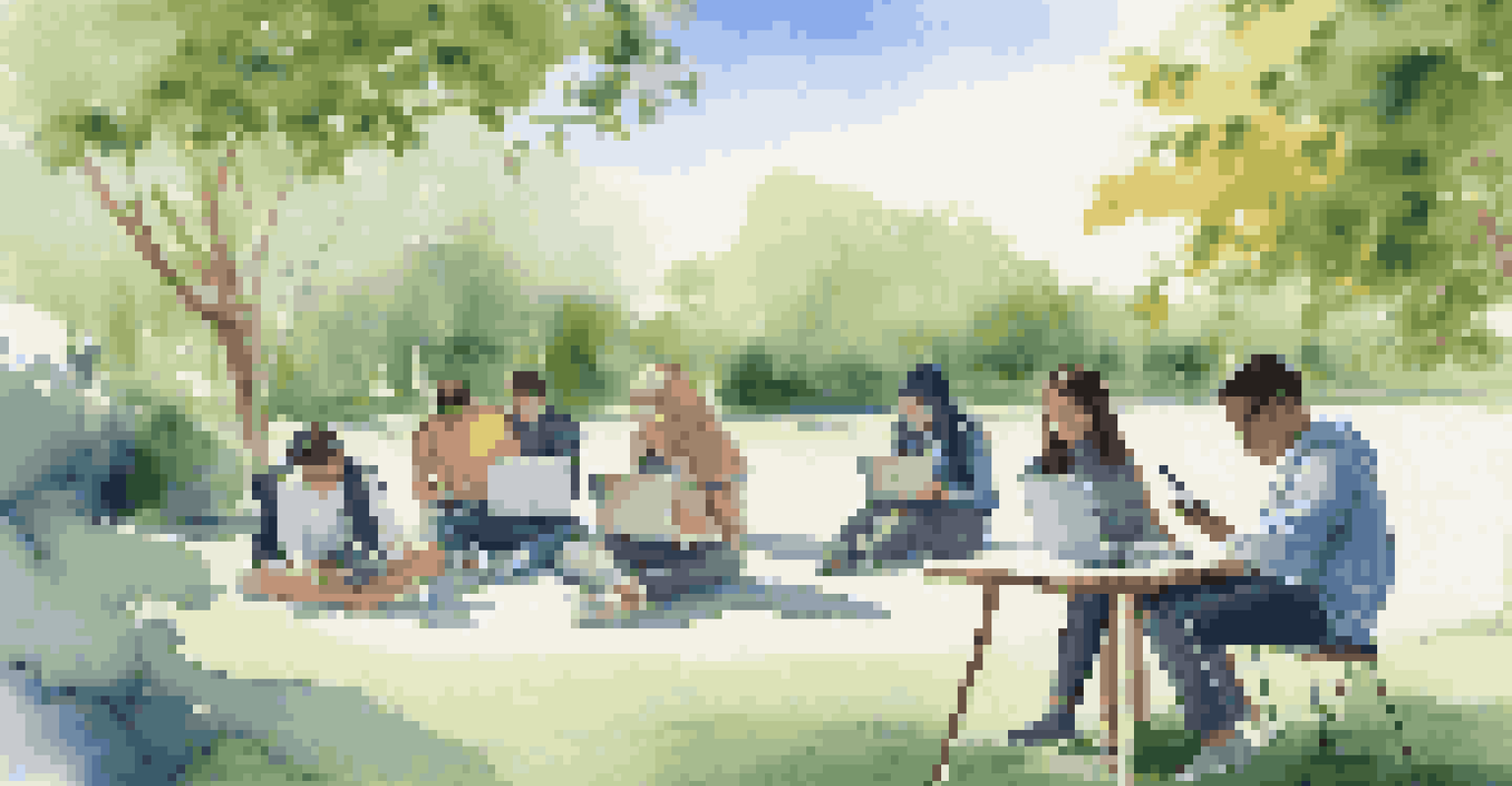Exploring the Role of Social Media in Transmedia Learning

Understanding Transmedia Learning: A Brief Overview
Transmedia learning refers to the use of multiple media platforms to convey information and enhance the learning experience. It allows learners to engage with content across various channels—like books, videos, and interactive games—creating a richer narrative. This method not only makes learning more engaging but also caters to different learning styles, ensuring that everyone can grasp the material in a way that suits them best.
The greatest gift of education is the ability to think critically and creatively in a world full of information.
At its core, transmedia learning emphasizes storytelling, where each platform adds a unique piece to the overall narrative. Think of it like a puzzle: each piece represents a different medium, and when put together, they create a complete picture. This approach can significantly boost retention and understanding by providing diverse perspectives and contexts.
In today's digital age, social media plays a pivotal role in shaping the way we engage with transmedia learning. Platforms like Instagram, Twitter, and YouTube are not just for social interaction; they are powerful tools for educational storytelling, allowing learners to explore concepts in dynamic and interactive ways.
The Role of Social Media in Enhancing Engagement
Social media platforms offer a unique way to enhance engagement in transmedia learning. By allowing learners to interact with content and each other, these platforms foster a sense of community and collaboration. For instance, a group of students might create a shared Twitter account to discuss themes from a novel, diving deeper into character motivations and plot developments.

Moreover, social media encourages active participation rather than passive consumption. Instead of merely reading or watching content, learners can create and share their own interpretations, leading to richer discussions and a deeper understanding of the material. This participatory culture can transform a solitary learning experience into a vibrant, collective journey.
Transmedia Learning Enhances Engagement
Utilizing various media platforms enriches the learning experience and caters to different learning styles.
Additionally, social media allows for real-time feedback and interaction with educators and peers. This immediate communication can clarify doubts, spark discussions, and motivate learners to explore topics more thoroughly, making the learning process more dynamic and responsive.
Fostering Collaboration Through Social Media
Collaboration is a cornerstone of effective transmedia learning, and social media platforms serve as excellent tools for facilitating this. They enable students to work together on projects, share resources, and brainstorm ideas, regardless of geographical barriers. For example, a group of learners from different countries can collaborate on a multimedia presentation using platforms like Google Docs and share their findings via Instagram or Facebook.
Storytelling is the most powerful way to put ideas into the world today.
These collaborative efforts can lead to diverse perspectives, enriching the learning experience. By engaging with peers from various backgrounds, learners are exposed to different viewpoints and cultural contexts, which can enhance critical thinking and creativity. This diversity can also make the learning process more enjoyable and fulfilling.
Furthermore, social media can provide a space for informal learning and mentorship. Students can connect with professionals or experts in a particular field, gaining insights and advice that might not be available within traditional classroom settings. This access to real-world knowledge can significantly enhance their educational journey.
Creating a Sense of Community Through Online Platforms
One of the most significant advantages of using social media in transmedia learning is the sense of community it fosters among learners. Online platforms can bring together individuals who share similar interests or educational goals, creating a supportive environment. This sense of belonging can motivate learners to engage more deeply with the content and each other.
In a community setting, learners can share their thoughts and experiences, encouraging open dialogues that enhance understanding. For example, discussion groups on platforms like Facebook or forums like Reddit allow students to ask questions and gain insights from their peers, making the learning experience more interactive and less intimidating.
Social Media Fosters Collaboration
Social media enables learners to collaborate across distances, sharing resources and diverse perspectives.
Additionally, communities built on social media can provide a safe space for learners to express their ideas and seek help. This supportive network can be especially beneficial for those who may feel isolated in their learning journey, helping to build confidence and resilience.
The Power of Storytelling in Transmedia Learning
Storytelling is a fundamental component of transmedia learning, and social media enhances this by allowing for diverse storytelling techniques. Through various media forms, learners can craft and share their narratives, whether it’s a blog post, a video, or a series of tweets. This flexibility encourages creativity and helps learners express their unique perspectives.
Moreover, social media enables learners to access a multitude of stories from different cultures and backgrounds. This exposure can broaden their understanding of global issues and human experiences, fostering empathy and critical thinking. By consuming and analyzing these stories, learners can connect theoretical knowledge to real-world applications.
Platforms like TikTok and YouTube have also transformed storytelling by promoting bite-sized content that captures attention quickly. This shift encourages learners to distill complex ideas into digestible formats, honing their ability to communicate effectively and engage their audience.
Challenges of Integrating Social Media in Learning
While the benefits of social media in transmedia learning are significant, there are also challenges to consider. One major concern is the potential for distraction; with so much content available online, learners may find it difficult to focus on their educational objectives. It's crucial to establish boundaries and guidelines to help students navigate their social media use effectively.
Another challenge is the issue of digital literacy. Not all learners are equally equipped to engage with social media as a learning tool. Educators must provide guidance and resources to help students develop the necessary skills to critically analyze content, engage respectfully, and contribute meaningfully to discussions.
Storytelling Boosts Understanding
Storytelling through social media promotes creativity and connects learners to global narratives and real-world applications.
Finally, privacy and safety concerns cannot be overlooked. Educators and learners alike need to be aware of the potential risks associated with sharing personal information online. Establishing clear communication and guidelines can help create a safe and supportive learning environment.
Future Directions for Social Media in Transmedia Learning
As technology continues to evolve, the role of social media in transmedia learning will likely expand. Emerging technologies like virtual reality (VR) and augmented reality (AR) open up new possibilities for immersive educational experiences. Imagine students exploring historical sites through VR while discussing their findings on social media—this integration could revolutionize engagement and understanding.
Additionally, the rise of artificial intelligence (AI) could personalize learning experiences on social media platforms. AI algorithms can analyze learners' preferences and tailor content accordingly, ensuring that each individual receives relevant information that meets their unique needs. This could enhance motivation and retention significantly.

Ultimately, the future of social media in transmedia learning will depend on collaboration among educators, technologists, and learners. By working together to harness the potential of these platforms, we can create innovative and impactful learning experiences that resonate with a diverse range of learners.